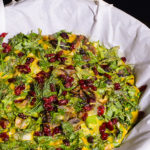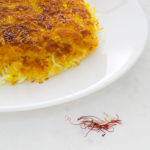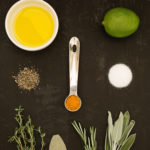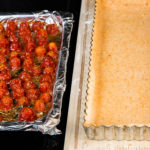
Hearing the words “turmeric” and “anti-inflammatory” in the same sentence was enough to put me on an experimental roll. My mother has rheumatoid arthritis. Functional foods that help prevent a recurrence of the pain and swelling – and keep her off of the steroids that induce what I unscientifically refer to as “Mighty Mouse” syndrome – are worth incorporating into our repetoire.
Coincidentally, I tired of Caribbean cooking. Somehow, everything tasted like adobo or a package of pre-mixed seasoning with achiote, the ground seed that gives color to arroz con pollo. Not that these Latin staples aren’t wonderful. They are. I grew up on them, loved them, depended upon them for years to deliver the base for many of my family’s favorite dishes. It was just that, these days, every time I tasted a dish using them, that was all I tasted. It was predictable. I was bored with the flavors.
The first thing to know about turmeric is that it stains everything. So did achiote. Would turmeric work in Spanish rice? Yes! The flavor is not identical, but I like it. It has depth, it’s different, it’s satisfying, and the cilantro provides reassurance, that yes, this is home. Turmeric works in red beans and black beans as well.
That was the end of my experimentation … for a while.
Then, I discovered a cookbook with a plethora of delicious recipes, many of which used turmeric, and many of which were are vegetarian.
A few months ago, my cousin’s husband, Terry, a communications professor, mused aloud that he’d like to travel to Iran. He is one of the more adventurous travelers I know. His wife sings in a chorus that travels. Between his business and her singing, they hike, sing, and lecture overseas several times a year.
Soon after, a woman I once worked with and always admired, Phyllis Stoller, who runs the Women’s Travel Group out of New York, announced her company was organizing a trip to Iran. Intriguing.
Around the same time, Check Please, our local public television food show, raved about a local Persian restaurant, offering an easy and affordable way to satisfy our culinary curiosity. The food was, as promised, delicious. The restaurant even had a little section with Persian spices for sale. The quest to replicate some of the dishes at home led me to Joon, Najmieh Batmanglij’s wonderfully approachable book of everyday Persian recipes. Many are vegetarian and many feature turmeric.
What followed was a month of sharing and photographing recipes from the book, including:
- Kuku, an egg-based dish where the eggs are a simply a vehicle for holding an abundance of vegetables or greens together, laced with fragrant spices;
- Turmeric & Lime Roast Chicken, with a beautiful deep golden color and a citrus kick;
- Turmeric & Ginger Chicken Soup, comforting and healthy; and
- Saffron Basmati Rice, with a crunchy layer of rice (tah-dig) mixed with saffron, yogurt, and olive oil. (I added turmeric to this, too.)
My favorite is Kuku Sabzi. It is quite appropriately a rite of spring. Overflowing with greens and herbs and flavored with advieh, a dried spice mix that includes rose petals, it is healthy and heady. Glistening garnet-colored barberries sauteed quickly in a splash of olive oil provide a jewel-like garnish.
Here’s a quick video followed by the recipe.
Joon! (Enjoy!)


- CARAMELIZED ONIONS
- ====================
- 4 tblsp olive oil
- 2 medium yellow onions, peeled and finely chopped
- GARNISH
- ========
- 1 tblsp olive oil
- 1/3 c. dried barberries, soaked in cold water for 15 minutes, and drained
- 1 tsp grape molasses or sugar
- 2 tblsp water
- BATTER
- =======
- 6 eggs
- 1 tsp baking powder
- 1 tblsp advieh (Persian dried spice mix, see Notes, below)
- 1-1/2 tsp sea salt
- 1 tsp freshly ground black pepper
- 1/2 tsp turmeric
- 2 cloves garlic, peeled and finely chopped
- 1/2 c. finely chopped Romaine lettuce
- 1/2 c. finely chopped spring onions (green and white parts)
- 1/2 c. finely chopped fresh parsley
- 1/2 c. finely chopped fresh cilantro
- 1/2 c. finely chopped fresh dill weed
- 1 tblsp dried fenugreek (optional)
- 1/2 c. coarsely chopped walnuts
- 1 tblsp rice flour
- 4 tblsp olive oil, for cooking kuku
- Preheat oven to 400 degrees Farenheit.
- Line a 9-1/2 by 13-inch rimmed sheet pan with parchment paper.
- Wash and dry the greens and herbs. By the time you add them to the batter, they should be dry.
- Caramelize the onions: Heat the oil in a wide skillet over medium heat. Saute the onions until golden brown, approximately 15-25 minutes. Place the onions in a bowl and set aside.
- Prepare the garnish: In the same skillet, place the oil, barberries, grape molasses, and the water, and stir-fry for 4 minutes over medium heat. Barberries burn easily, so remove them as soon as they are soft and glistening. Transfer to a bowl and set aside.
- Prepare the batter: Break the eggs into a large mixing bowl. Add the baking powder, advieh, salt, pepper, and turmeric. Beat lightly with a fork. Add the garlic, lettuce, herbs, walnuts, flour, and caramelized onions, and fold in gently using a rubber spatula.
- Cook: Use a pastry to capture the oil from the skillet used to caramelize the onions (or use the 4 tblsp olive oil at the end of the ingredient list) and brush the parchment paper with oil. Pour in the batter. Gently shake the pan to even out the batter. Bake 15 minutes.
- Garnish: Remove from the oven and place on a cooling rack. Garnish with the caramelized barberries. Cut the kuku into serving-size pieces. Serve hot or at room temperature with lavash bread and yogurt.
- ADVIEH
- =======
- 1 tbsp dried rose petals (available on Amazon)
- 1 3-inch cinnamon stick, crushed (to help grind the other spices)
- 1 tbsp cardamom
- 1 tbsp cumin
- 1/2 tbsp ground golpar (also available on Amazon)
- Grind ingredients in a mortar and pestle. Use what is needed for the recipe above and store the rest in a cool dry place in an airtight container. (Yield: Approx. 1/4 cup)







